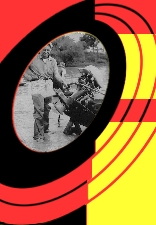 |
 |
Introduction
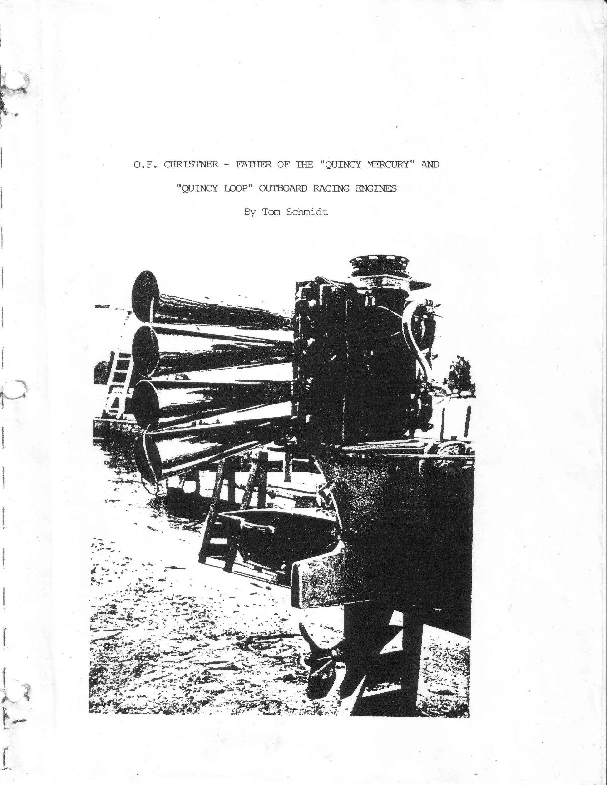 |
O.F. CHRISTNER - FATHER OF THE “QUINCY MERCURY” AND
“QUINCY LOOP” OUTBOARD RACING ENGINES
By Tom Schmidt
|
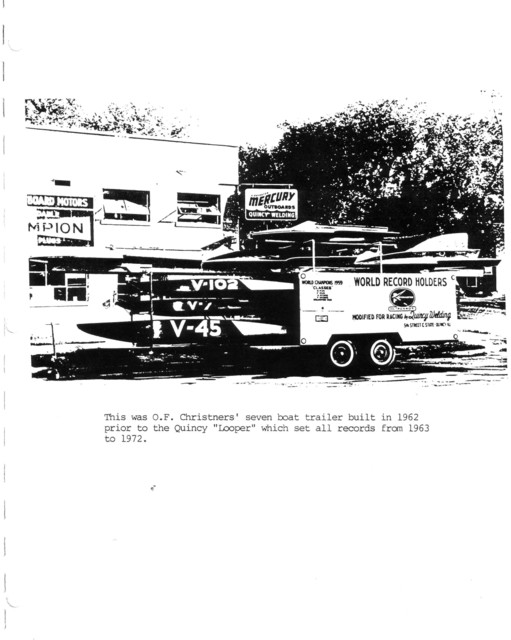 |
This is taken from the biography written in 1991 by Tom Schmidt in recognition of O.F. Christner's contributions to outboard racing. It is presented here with the permission of the author, Mr. Tom Schmidt. Mr. Schmidt has copies of the full biography available for those interested in reading the entire book. The Christner family thanks Tom Schmidt for his contribution to this site.
|
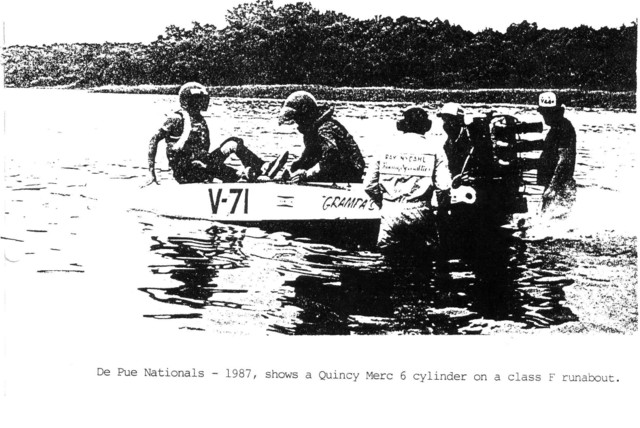 |
Perhaps no other sound in water sports has the exciting unforgettable soul stirring effect as does the Quincy “Looper” outboard racing engine when it is fired up in the pits and goes out to run on the race course. Whether you are a fan or another driver, you always sit up and take notice of that engine revving up to 9000 RPM’s in hopes that it will hold together. In the professional outboard racing and the modified classes, this “alky” racing version of the Mercury outboard has been and still is, in some cases, the holder of speed records of the APBA record books for over 30 years. The story of the Quincy “Looper” and how it evolved is an interesting one, so I wrote a letter to its designer and creator O.F. Christner, now retired and living in Sarasota, Florida, asking if he would document the details of its development in writing so it would be preserved for all to read. Not much is written about this sport in general and from a historical standpoint his contribution should not go unnoticed.
|
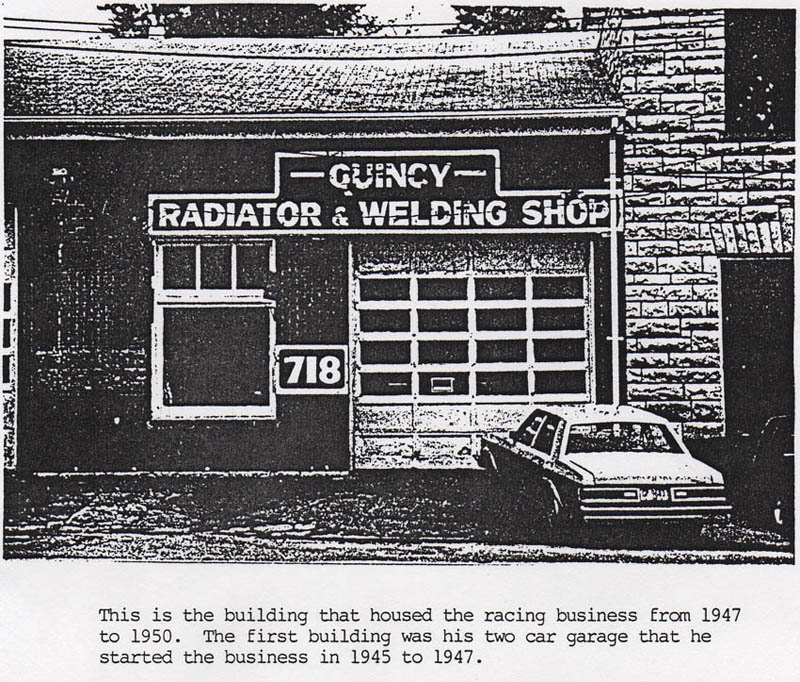 |
Before all of this occurred , the outboard racing scene was dominated by the Evinrude Speedi Twin, Big Four and a 4-60 as well as the Johnson PO, PX 50, PR and XR outboard engines modified for racing and using methanol, castor oil, acetone and benzol instead of pump gasoline. In the 20's, 30's and 40's they were very highly modified within APBA and NOA guidelines. These two sanctioning organizations, the American Power Boat Association and The National Outboard Association were the backbone of the racers individual and regional clubs with NOA specializing in the “alky” classes and the APBA in the “stock” outboard classes. By the late 60's the APBA had controlling interest in the whole affair and basically that is where it stands today. But the dominance of the Evinrude and Johnson motors was challenged after World War II when the Mercury motor came on the scene. The company was founded in 1939 by Carl Kiekhaefer but it wasn’t until 1947 that the Mercury motors made a serious challenge to the outdoor racing picture. This is where our story about the Merc-Quincy and eventually the Quincy “Looper” and O.F. Christner begins.
|
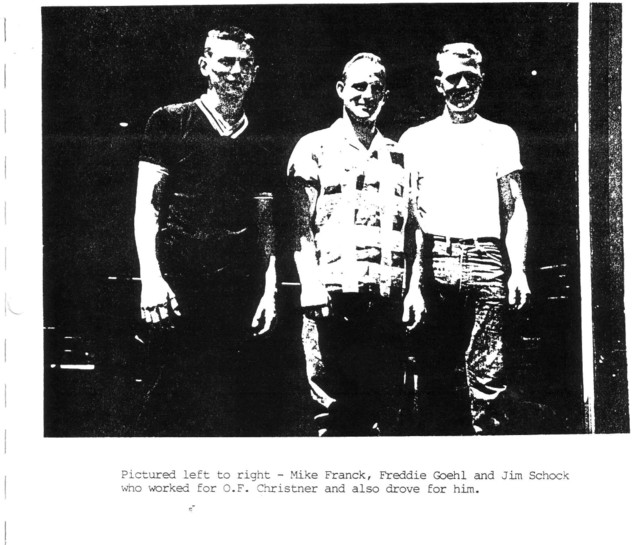 |
When I wrote to O.F. Christner and asked him to do this story, he said “Ok, I’ll send you some photos and write down as much as I can remember.” So, what I received, along with other information I got by writing to other racers is what compromises this story. O.F. Christner was born and raised on a farm in Mendon, Illinois, a town of about 500 people near Quincy, Illinois. He recalls “When I was young and growing up I realized that I didn’t like farm work but did like to work on tractors and automobiles. So, at the age of ten I was doing this on my father’s equipment and went to work as an auto mechanic evenings and on non-school days at the age of fourteen.” O.F. says, “I followed this type of work for many years along with welding and doing machine work.” He must have been very good at this because it would be the basis for his future business, Quincy Welding and Marine.
|
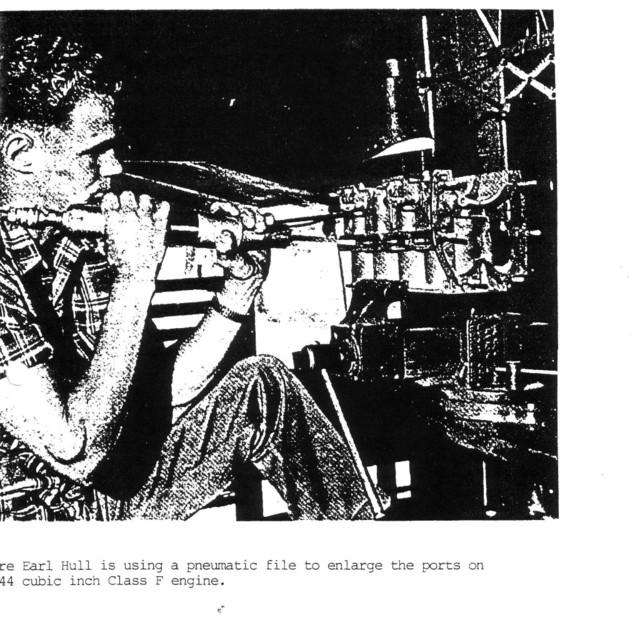 |
At this time, O.F. goes on, “At the urging of a friend we bought a boat to use for fishing which had a five horsepower Muncie outboard engine on it.” this was his first experience with a two-cycle motor. This was during World War II, 1942-1943, when new outboard motors were scarce because of the war effort and the five horsepower Muncie seemed such a slow way to get somewhere. He decided to go shopping for a larger motor and bought a ten horsepower Neptune which was also made by Muncie Gear Works, the builder of the five horsepower version. That motor was too big for the boat so O.F. proceeded to build a boat for the motor. This resulted in a 16 foot skiff which then became too large for the motor so he bought a 33 horsepower Evinrude. That combination must have given him the bug for speed and he recalls, “It really went like the wind.” O.F. continues, “Having gotten my feet wet, now I became a Mercury outboard dealer in 1946 and when the Mercury Lightning came out in 1947, it was light and quite powerful, I started racing as did many other people at that time.”
|
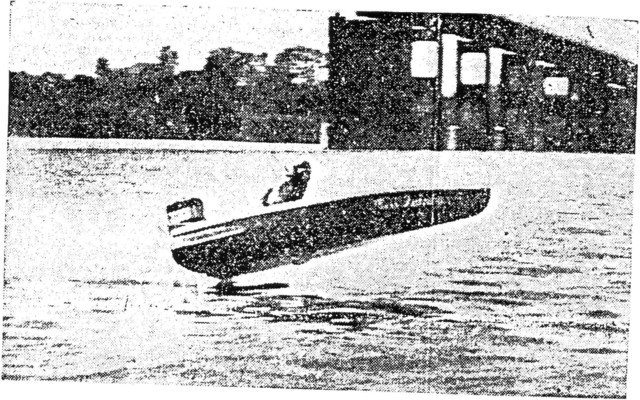 |
He was fairly successful at this. In 1948 he competed in an outboard marathon in Alton, Illinois, and came in at first place in the old AAR class, the boat was named “Miss Quincy,” a name that would later achieve notoriety. The marathon was a 60 mile event and O.F. recalls, “I was worn out.” Then in October 1949 things began to happen. O.F.> and Edwin Palmer took a stock utility boat and a stock 25 horsepower Mercury motor to Lake Alfred, Florida and recorded the fastest time in the mile trials in its class and in the entire event. Palmer drove the boat over the measured mile and an average speed of 43.426 miles per hour. There were 28 competitors in the 25 horsepower class and Palmer’s time was faster than that set by anyone in the 33 or 50 horsepower classes as well! This event was the first time national championships were held for stock utility boats and the time was automatically classifies a world record. The water was calm on Lake Alfred and O.F. reported, “If there had been a chop such as on the Mississippi River the time trials would have been considerably better.”
From the beginning they did not have any way of measure power other than doing home experimenting on the engine and put it on a boat, go down to the river, which was about a mile from the shop, and run a certain course which they had set up on the west side of the Mississippi on the Missouri side, about a mile or so south of Quincy, Illinois. O.F. recalls, “You can imagine with the weather, wind and winter time how difficult that was. In the winter the river froze over and the Spring and Fall were too cold so we really only had about four months to test engines.” The course was about 5/8 of a mile in length. I visited that area recently and wondered how that must have felt like being on the river testing racing boats and engines. It was something I was fascinated with when I was young, for I had attended my first boat racing in 1949, drove my first hydro in 1951, a Class C service rig, then drove a Class C runabout in 1952. My last hydro was Class F which I drove from 1973 to 1978 by for some reason my family discouraged my activity so I sold the boat.
O.F. then says, “Later on we went to running certain size test wheels instead of props on an outboard engine tank and inside the building so testing could go along much better.” His first building was his garage and as time went on he would increase the business and move to other locations.
|
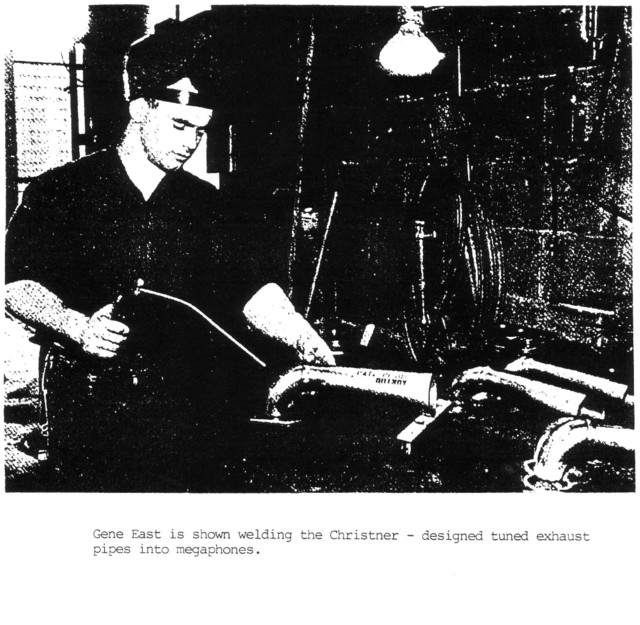 |
In those early days a need for more power arose and O.F. started modifying the Mercury engines and compete with the Johnson racing engines which were the motors used in racing at that time. “At first,” he continues, “classes were set up for the Mercs as they couldn’t compete with the Johnsons which were built really for racing.” The SR-B engine and the PR-C and KR-A engines he was referring to as well as the Big Four, 4-60, Px-50, PR and SR all Evinrude or Johnson racing engines. The shop grew and had to be moved from the garage location to another site where more machining could be done. Quincy Welding and Marine was involved in tank welding as well as automobile welding and machining and this was the mainstay of the business.
As time wore on, between 1950 and 1956, “We were able to increase the power of the different Mercury engines mainly by welding a pad in the combustion chamber and converting to alcohol fueled which brought the Mercs up to the speed of the Johnsons so we were running with them.” he said. “The pads for the closed end cylinders of the engine were at first made from copper and then from aluminum. When the word got out that we could pad Merc cylinders the business picked up tremendously.” O.F. recalls. “Pep” Hubbel of California who was the Johnson soup-up man heard about Christner’s work and sent him cylinders to pad. “Pep” Hubbel was known around the world for his work on Johnsons as he built complete racing engines using Johnson components supplied by the factory.
Click on Link for Page 2
|
|
|
